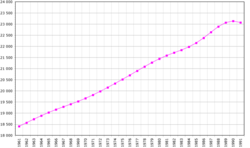Demographics of the Socialist Federal Republic of Yugoslavia
Demographics of the Socialist Federal Republic of Yugoslavia, during its existence from 1945 until 1991, include population density, ethnicity, education level, health of the populace, economic status, religious affiliations and other aspects.
Some of the largest non-Slavic ethnic minorities – Hungarians of Serbia, Germans (predominantly Danube Swabians), Kosovar Albanians and Istrian Italians – had been considered "troublesome" by Yugoslav authorities already in the first, interwar Yugoslavia, in part for supporting their ethnic interests and nation states as opposed to pan-Slavic ambitions during World War I.
Nonetheless, local Germans collaborated with the Nazi occupation forces during World War II, and ethnic Hungarians generally welcomed the return of Bačka region to Hungary.
After World War II, around 250,000 Germans and Italians were expelled or fled from the country, fearing reprisals, their property confiscated, in the events known as the expulsion of Germans after World War II and Istrian–Dalmatian exodus, the latter in the newly annexed areas in Istria and Rijeka, as well as from Dalmatia.
Some Czechs and Slovaks also emigrated after the war, but a "large number" of them returned after communists seized power in Czechoslovakia in 1948.


